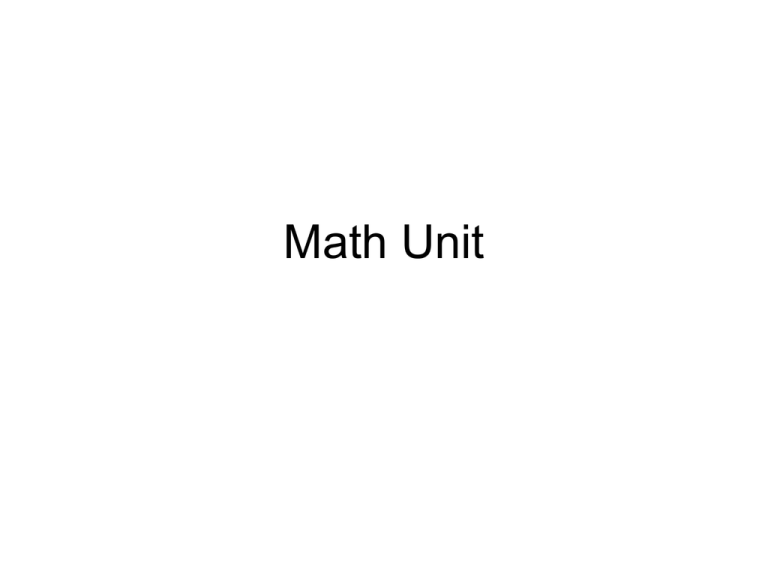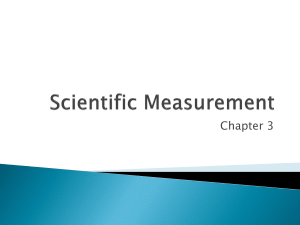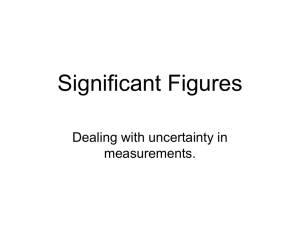Math Unit Honors Chem
advertisement

Math Unit Measurement • When making any measurement, always estimate one place past what is actually known. Example • For example, if a meter stick has calibrations (markings) to the 0.1 cm, the measurement must be estimated to the 0.01 cm. • If you think it’s perfectly on a line, estimate the last digit to be zero – For example, if you think it’s on the 2.1 cm line, estimate it to 2.10 cm. Electronic Devices • When making a measurement with a digital readout, simply write down the measurement. The last digit is the estimated digit. Significant Digits • Significant digits are all digits in a number which are known with certainty plus one uncertain digit. 5 Rules for Counting Significant Digits in a Measurment 1. All nonzero numbers are significant. – 132.54 g has 5 significant digits. 2. All zeros between nonzero numbers are significant. 130.0054 m has 7 significant digits 3. Zeros to the right of a nonzero digit but to the left of an understood decimal point are not significant unless shown by placing a decimal point at the end of the number. 190 000 mL has 2 significant digits 190 000. mL has 6 significant digits 4. All zeros to the right of a decimal point but to the left of a nonzero digit are NOT significant. 0.000 572 mg has 3 significant digits 5. All zeros to the right of a decimal point and to the right of a nonzero digit are significant. 460.000 dm has 6 significant digits Shortcut • If the number contains a decimal point, draw an arrow starting at the left through all zeros and up to the 1st nonzero digit. The digits remaining are significant. Exact Numbers Exact numbers have an infinite (∞) number of significant digits. 3 types of numbers with (∞) number of sig digs: 1. Definitions (12 eggs = 1dozen) 2. Counting numbers (there are 24 desks in this room 3. Numbers in a formula (2pr) Try these • • • • 0.002 5 1.002 5 0.002 500 0 14 100.0 • If the quantity does not contain a decimal point, draw an arrow starting at the right through all zeroes up to the 1st nonzero digit. The digits remaining are significant. Try these • • • • 225 10 004 14 100 103 Remember – Atlantic Pacific • Decimal Point Present, start at the Pacific. • Decimal Point Absent, start at the Atlantic. How many significant digits do these have? • • • • • 1.050 20.06 13 0.303 0 373.109 • • • • • 420 000 970 0.002 0.007 80 145.55 Rounding Rules Round up if the digit immediately to the right of the digit you are rounding to is • Greater than 5 • • Round 0.236 to 2 significant digits 5 followed by another nonzero number • • Round 0.002351 to 2 significant digits Round 0.00235000000001 to 2 significant digits Kepp the digit the same if the digit immediately to the right of the digit you are rounding to is • Less than 5 • round 1.23 to 2 significant digits What if the digit to the right of the number you are rounding to is 5 and there’s nothing after it? • That means you are perfectly in the middle. • Half of the time you must round up and half of the time you must round down. • There are 2 rules for this Look to the digit to the right of the number you are rounding to. • If it is even – keep the same. – Round 0.8645 to 3 significant digits • If it is odd – round up. – Round 0.8675 to 3 significant digits. Round These to 3 significant digits • • • • • 279.3 32.395 18.29 42.353 0.008 752 • • • • 18.77 7.535 32.25 5 001 Applying significant digits to arithmetic operations Addition and Subtraction • Look at the numbers being added or subtracted and identify which one has the lowest number of decimal places. Calculate the answer. Round the answer to the lowest number of decimal places. Examples • 14.565 + 7.32 = 21.885 • 7.32 has only 2 decimal places, so the answer should be rounded to 21.88 • 143.52 – 100.6 = 42.92 • 100.6 has only 1 decimal place, so the answer should be rounded to 42.9 Multiplication and Division • Look at the numbers being multiplied or divided and identify which one has the lowest number of significant digits. Calculate the answer. Round the answer to the lowest number of significant digits. Examples • 172.6 x 24.1 = 4159.66 • 24.1 has only 3 significant digits, so the answer should be rounded to 4160 • 172.6 ÷ 24.1 = 7.161 82 • 24.1 only has 3 significant digits, so the answer should be rounded to 7.16 Practice • • • • • • • • Add 5.34 cm, 9.3 cm, and 12 cm. Subtract 4.31 cm from 7.542 cm. Subtract 1.512 g from 16.748 g. Add 2.572 5 m, 14.55 m and 0.035 m. Multiply 176.335 and 0.003 2. Divide 475.90 by 35. Multiply 0.000 565, 1.579 52, and 45.006 86. Multiply 1 456.00 by 0.035 0 and divide that by 17.070. Percent Error • This is a way of expressing how far off an experimental measurement is from the accepted/true value. • Final Exam Question Formula Value accepted - Value experimental Value accepted X 100 Scientific Notation • It is used for extremely large or small numbers. • The general form of the equation is: m x 10n • With the absolute value of m ≥ 1 and < 10 Practice • • • • 12 300 -1 456 0.005 17 -0.000 6 • • • • 6.650 x 102 3.498 x 105 -2.208 x 10-3 1.1650 x 10-4 Arithmetic Rules for Scientific Notation • Follow the same rules for math operations with scientific notation as you would with standard notation. Addition and Subtraction • • • • (3.37 x 104) + (2.29 x 105) (9.8 x 107) + (3.2 x 105) (8.6 x 104) – (7.6 x 103) (2.238 6 x 109) – (3.335 7 x 107) Multiplication and Division • • • • (1.2 x 103) x (3.3 x 105) (7.73 x 102) x (3.4 x 10-3) (9.9 x 106) (3.3 x 103) (1.55 x 10-7) (5.0 x 10-4) Temperature Conversion • Temperature is defined as the average kinetic energy of the particles in a sample of matter. • The units for this are oC and Kelvin (K). Note that there is no degree symbol for Kelvin. Kelvin Scale • The Kelvin scale is based on absolute zero. • This is the theoretical temperature when motion stops. • Heat is a measurement of the total kinetic energy of the particles in a sample of matter. • The units for this are the calorie (cal) and the Joule (J). Formulas • T(K) = t(oC) + 273.15 • t(oC) = T(K) - 273.15 Dimensional Analysis • Dimensional analysis is the algebraic process of changing from one system of units to another. You must develop the habit of including units with all measurements in calculations. Units are handled in calculations as any algebraic symbol: Numbers added or subtracted must have the same units. Units are multiplied as algebraic symbols. For example: 10 cm x 10 cm = 10 cm2 Units are cancelled in division if they are identical. For example, 27 g ÷ 2.7 g/cm3 = 10 cm3. Otherwise, they are left unchanged. For example, 27 g/10. cm3 = 2.7 g/cm3. Conversion Factor • These are fractions obtained from an equivalence between two units. • For example, consider the equality 1 in. = 2.54 cm. This equality yields two conversion factors which both equal one: • and 2.54 cm 1 in 2.54 cm 1 in Convert 5.08 cm to inches • 5.08 cm x 1 in 2.54 cm = 2.00 in Convert 6.53 in to cm • 6.53 in x 2.54 cm 1 in = 16.6 cm Here are some common English/metric conversions. You will not need to memorize these. 1 mm = 0.039 37 in 1 cm = 0.393 7 in 1 m = 39.37 in 1 Km = 0.621 4 mi. 1 quart = 946 ml 1 quart = 0.946 L 1 in = 2.54 cm 1 yd = 0.914 40 m 1 mile = 1.609 Km 1 pound = 453.6 g 1 ounce = 28.35 g Converting within metric units • In section 2-5 of your textbook, you learned the relationship between metric prefixes and their base units. You need to have these relationships memorized to do these problems. • When you write your conversions factor, always use the number 1 with the unit with the prefix and meaning of the prefix with the base unit. Examples 1 mg 0.001g 1 ns 10 -9 s 1000 m 1 Km Try to set up these conversion factors W GW cm m Tb b L L dL mL L pg








